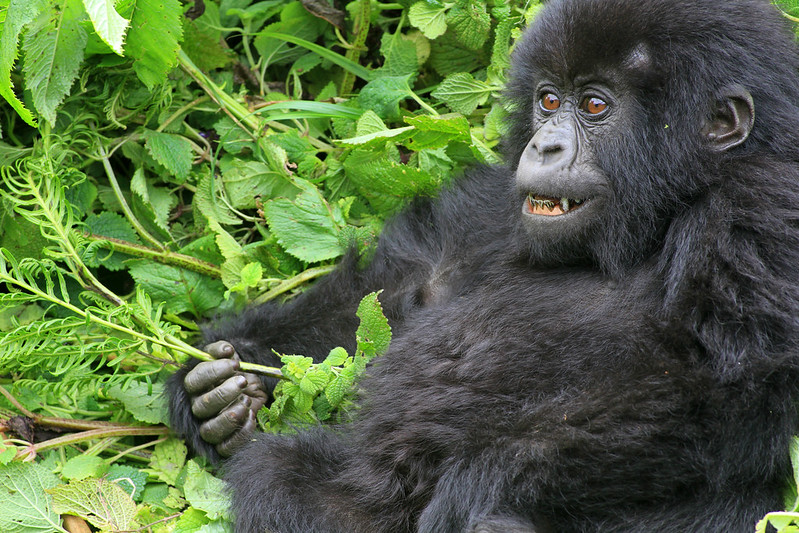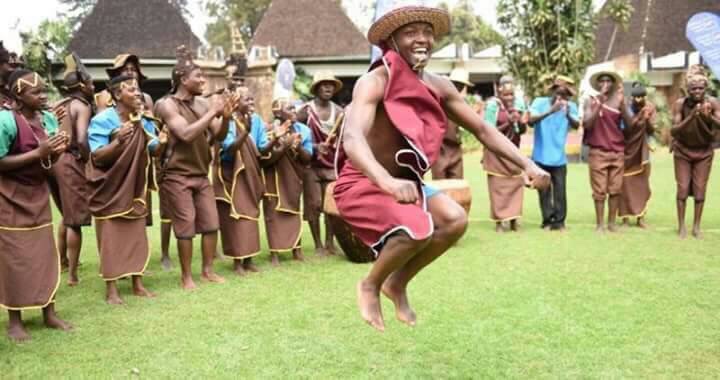Facts about Volcanoes National Park Rwanda
Facts about Volcanoes National Park Rwanda, Volcanoes National Park is situated in the northwestern region of Rwanda, adjacent to Virunga National Park in the Democratic Republic of Congo and Mgahinga Gorilla National Park in Uganda. The national park, established in 1925, is the oldest national park in Africa, encompassing a total area of 160 square kilometers. It features diverse vegetation zones that support various wildlife species, including mammals such as forest elephants, buffaloes, bush pigs, duikers, and bushbucks, as well as primates like the endangered mountain gorillas and golden monkeys. Additionally, it is home to bird species including the Ruwenzori turaco, handsome francolin, strange weaver, red-faced woodland warbler, Ruwenzori batis, and archers ground robin, alongside the volcanic mountains of Karisimbi, Muhabura, Bisoke, Sabyinyo, and Gahinga.

Principal attractions and activities in Volcanoes National Park
Gorilla trekking
Volcanoes National Park is one of four locations in Africa that shelter the endangered mountain gorillas; the other locations include Virunga National Park in the Democratic Republic of Congo, Bwindi Impenetrable National Park, and Mgahinga Gorilla National Park in Uganda. Gorilla trekking is a prominent activity in Volcanoes National Park, entailing an expedition into the forest to locate mountain gorillas, after which participants spend one hour in their natural habitat. Volcanoes National Park is home to around 11 habituated gorilla families that are visited everyday. The trekking commences early in the morning with a training on the park’s rules and regulations at the headquarters, after which visitors will be separated into groups of eight, with each group assigned a certain gorilla family to walk. Gorilla trekking in Volcanoes National Park lasts between 30 minutes and 7 hours, contingent upon the gorillas’ location, as they frequently relocate in pursuit of food. While trekking, you will encounter various primate species, avian species, and diverse flora. Upon locating the gorillas, you will be permitted to spend one hour in their natural habitat, providing an opportunity to observe their daily behaviors, such as feeding, nursing, playing, and grooming, as well as to capture photographs and record moments using a flash-free camera.
Golden monkeys trekking in Volcanoes national Park
Golden monkey trekking is an essential activity in Volcanoes National Park that should not be overlooked during your safari. The program commences with a training at the park headquarters at approximately 7:30 am. Following the briefing, participants will be organized into groups and assigned an experienced park guide proficient in the jungle trails. Golden monkey trekking is less arduous than gorilla trekking, requiring between 30 minutes to 4 hours, contingent upon the location of the golden monkeys. Golden monkeys do not provide distinct traces of their prior whereabouts; hence, trackers identify them by observing fresh remnants of bamboo shoots. Upon locating the golden monkeys, you will have the opportunity to spend one hour with them, allowing for photography, observation of their arboreal acrobatics, feeding, and playful interactions, among other activities.
Volcanic hiking
The Virunga Mountains comprise a chain of eight volcanoes, five of which are located in Volcanoes National Park. These include Mount Bisoke, a dormant volcano standing at 3,711 meters above sea level, featuring a substantial crater lake at its summit; Mount Karisimbi, the tallest volcano in the Virunga range, reaching an altitude of 4,507 meters; Mount Gahinga, the shortest mountain in Volcanoes National Park, at 3,474 meters; Mount Muhavura, which rises to 4,127 meters and boasts a picturesque crater lake at its peak; and Mount Sabyinyo. While ascending the volcano, you will traverse multiple pathways that meander through dense forests, offering spectacular vistas of mammals, primates, avian species, and diverse vegetation kinds, among others.
Discovering the Musanze caves
The Musanze caves are thought to have been created by a volcanic eruption approximately 65 million years ago. The Musanze caves extend 2 kilometers into the earth’s surface, featuring enhanced pathways, stairs, and walkways that guide tourists into the caves’ dark core. The caves served as refuge and concealment during historical conflicts, providing visitors with spectacular vistas of the Virunga ranges, including Mount Karisimbi, Gahinga, and Muhabura, as well as views of water streams cascading from the rock ceiling and bats suspended on the cave walls, along with water drips, among other features. The caves are enveloped in perfect quiet, thus the only sounds during exploration are whispers, fluttering bats, and echoes of human voices. Visitors to the Musanze cave expedition are equipped with powerful torches, helmets, gloves, boots, and masks to facilitate navigation through the tunnels.

Ibyiwacu Cultural Tour
Volcanoes National Park also provides the Ibyiwacu Cultural Tour, an engaging activity that allows for interaction with the local populace in the adjacent village. On the cultural tour, you will gain insights into the local populace’s lifestyle, culture, traditions, and agricultural practices. You will learn to produce local banana beer, sample traditional cuisine, visit the King’s palace, experience entertainment through music, dance, and drama, and purchase handcrafted items, among other activities.

Best time for visiting Volcanoes National Park
Volcanoes National Park is accessible year-round, although the optimal visiting period is during the dry season, specifically in June, July, August, September, October, December, January, and February. In the dry season, less rainfall in the park results in sparse vegetation, facilitating clear visibility of many wildlife species. Hiking and walking trails remain accessible, unlike in the wet season when they become muddy and treacherous.
Accommodations in Volcanoes National Park
Volcanoes National Park offers a variety of accommodation options for your safari, including luxury, mid-range, and budget hotels. The accommodations comprise Ruzizi Tented Camp, Kinigi Guesthouse, Karenge Bush Camp, Hotel Muhabura, Da Vinci Gorilla Lodge, Garr Hotel, Gorillas Volcanoes Hotel, Villa Gorilla, Sabyinyo Silverback Lodge, Mountain Gorilla View Lodge, Virunga Lodge, Best View Hotel, Five Volcanoes Boutique Hotel, Gorillas Nest Lodge, Le Bamboo Gorilla Lodge, La Palme Hotel, Bisate Lodge, and Garden Place Hotel, among others.
Directions to Volcanoes National Park
Volcanoes National Park is situated in the northwestern region of Rwanda and requires approximately 2 to 3 hours of driving from Kigali. Feel free to reach out to Gorilla Trekking in Africa for further information regarding Volcanoes National Park or safari reservations.
